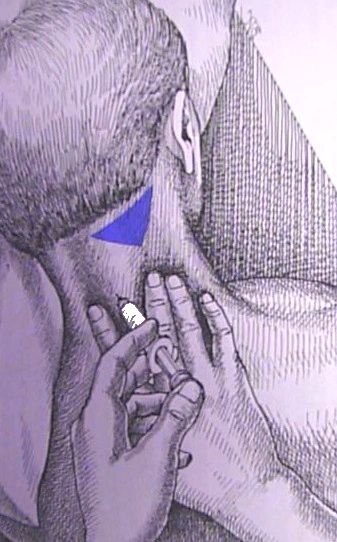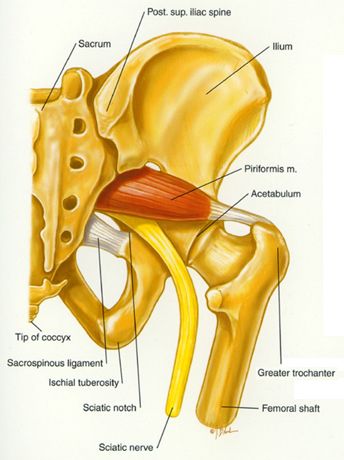Pain Blocks
What are Pain Blocks?
 |
Pain Blocks are injections given to reduce chronic pain conditions. These blocks are typically performed by pain management doctors such as Dr. H. Rand Scott at Newport Pain Management. There are many different specific pain blocks that can be done to help reduce your pain. Common pain blocks include trigger point injections, epidurals, nerve blocks, and facet blocks. Most pain blocks are done with a local anesthetic such as bupivacaine, and a form of cortisone.
How do Pain Blocks Work?
The honest answer is that we really don't know for sure. We know that in some instances, the injection itself causes the body to release painkillers. Local anesthesia can relax tight muscles by temporarily paralyzing them. Other times, blocks can actually relieve pressure on nerves by reducing local inflammation. Cortisone itself may have a pain blocking ability when injected near nerves.
Do Pain Blocks Hurt?
At Newport Pain Management, we have a variety of ways to make your experience more pleasant. Ask Dr. Scott about your concerns. The good news is that some blocks take only seconds, and most less than 5 minutes. Most of the time spent in the procedure room is spent on getting you comfortable and in setting up for the procedure. While it would seem like a good idea to be "asleep" for most pain blocks, this is not recommended by most pain doctors as this can add to the risks of the procedure.
Risks with Pain Blocks
The risks from having pain blocks vary with the needle placement and the medication injected. In general, any needle used for injection can cause more pain, bleeding, swelling, permanent nerve damage and even infection. Pain medications injected carry their own set of risks. Some but not all risks include numbness and weakness, heart effects, dizziness, weight gain, increase in blood sugar and suppression of the body's immune system. Fortunately, allergic reactions are rare with local anesthetics and cortisone type medicines.
Is There a Limit on How Many Blocks I can Have?
Corticosteroids such as Cortisone are near cousins to those produced in the body by the adrenal gland. Artificial injections of these corticosteroids in pain blocks can cause your body to stop making its own supply, and cause atrophy of the adrenal gland. This can cause you to feel ill. Thus many pain specialists will limit these corticosteroid injections depending on your circumstances. Always inform your pain specialist about any other forms of corticosteroids you have taken, including other injections by orthopedists or your primary doctor, steroid creams, asthma medications or arthritis or allergy treatments.
Epidural Steroids
| Getting Better Faster |
You wake up with severe back pain going down your leg. Every movement is torture. You call you Doctor, and she says rest a few days and take naproxen. You do, and nothing changes that shooting pain going down the leg. She prescribes you some hydrocodone, and a muscle relaxer. It helps some, but they mess with your head, and you know this isn't good for you. You go to your chiropractor, but after a few hours you are back in pain. What to do?

Epidural steroid injections can be effective for reducing back pain that radiates down the leg. Pain that goes down the leg is often an indicator of a "pinched nerve" in the back. This means that something is pushing on the nerve that supplies feeling, strength and reflexes to your leg. Typically the cause of the pinching is the disc that cushions the vertebral bones. A small outward change in shape of the disc is called a "bulge" with more severe change in shape called a "herniated disc."

Lumbar Epidurals
An epidural steroid block is placement of local anesthetic and a powerful anti-inflammatory known as a corticosteroid in the layers of tissue that surround the spinal cord and spinal nerves. These injections are typically performed in surgicenter by a pain specialist such as H. Rand Scott, M.D.. Anesthesiologists such as Dr. Scott are trained to perform routine epidural blocks for patients having surgery or for women in labor. A lumbar epidural block for sciatica (back and leg pain) is very similar to that done for surgery. For surgery, strong local anesthetics are injected in the back, but for back pain, local anesthetics and corticosteroids are typically given.
Do Epidurals Cause Hair Loss?
No. Certainly the stress of having severe pain can cause hair loss, so perhaps this is the source of this myth.
When Should I get an Epidural Steroid Block?
Epidural steroid blocks for neck pain or low back pain typically work best if done within 6 months of the onset of your pain. The longer your back pain persists, the less likely any intervention, including surgery will help. If you have chronic back or neck pain, epidural steroids in conjunction with the right medications can help you get through the initial added discomfort of physical therapy. If you have had pain a long time, epidural steroids can also help you after suffering a setback in your recovery. While in this instance the epidural may not relieve your pain, it can help get your chronic pain back to your baseline without you having to increase pain medications and increase medication side effect. Many people with back and neck pain simply do not want to have surgery, and thus epidural steroid blocks can be a viable pain treatment option.
Trigger Point Blocks
 |
If you can identify a small area of the body that is tender and feels like a ‘knot’—this area may be known as a trigger point. In other words, this area may be the spot that triggers your pain. These trigger areas may be seen in people with fibromyalgia, tension headaches, myofascial pain, or as a consequence of another injury such as in injuries to the back or other areas of the body.
This trigger area can be made less painful with an injection. Injection success is often enhanced by performing daily stretching of the injection area.
How are Trigger Point Injections Done?
Many different substances have proven beneficial for trigger point injections. Typically bupivacaine or ropivacaine, long acting forms of local anesthetics, are combined with a form of cortisone such as triamcinolone or betamethasone. Some studies even show that small amounts of Botox can be beneficial. The needles used are much smaller than used to draw blood. While no injection is pleasant, most patients look forward to these injections as they can provide immediate pain relief.
SacroIliac Joint Block
The sacroiliac joint can be an overlooked source of dull low back pain in many individuals. The sacroiliac joint connects the pelvic bone to the base of the spinal bones.

Weight gain and sedentary lifestyle can add greatly to the stress on this joint. A sacroiliac block can be very helpful in reducing lower back pain. Ask Dr. Scott if a sacroiliac block can help.
Nerve Blocks
 |
Peripheral nerve blocks can help pinpoint the source of pain. They can also treat pain at the same time. Nerve blocks can treat pain as diverse as headaches, nerve damage such as a from cancer or neuroma growth after surgery, pain from shingles, known as post herpetic neuralgia, or reflex sympathetic dystrophy- a condition of intense skin pain with even the slightest touch. Many different techniques and medications are used for nerve blocks, depending on the location and position of the block. For pain radiating down the back of the leg, a sciatic nerve block may prove helpful. See the diagram above. An intercostal block can reduce shingles pain in the chest. Neuroma blocks can reduce pain from nerve damage after trauma or surgery. Dr. Scott at Newport Pain Management can find out if a peripheral nerve block can reduce your pain.
Facet Blocks
A common cause of low back pain is wear and tear in the spots where the vertebral bones of the back connect to the other vertebral bones that sit above and below them. Doctors call this wear and tear "osteoarthritis", and when combined with aging of the vertebral discs, is commonly called degenerative disc disease.
A facet block is an injection of a corticosteroid and local anesthesia just outside the joint where two vertebrae join together. This injection can be both diagnostic and therapeutic. In other words, the injection can sometimes both help pin point the location of the your back or neck pain, and treat the pain as well. When the osteoarthritis is severe, facet joint blocks tend to provide only temporary pain relief. At Newport Pain Management, we can get you moving again.

Call for an appointment today
949.759.8400
Newport Pain Management
The information on this website is not intended to be a substitute for professional medical advice. You should not use this information to diagnose or treat a health problem or disease without consulting with the Pain Doctor's at Newport Pain Management Medical Corporation or a qualified healthcare provider. Please consult your healthcare provider with any questions or concerns you may have regarding your condition.
